|
more 1920s topics Nostalgia Cafe main page Nostalgia Cafe site map | 1920s Movies & Theater============================================================ ============================================================ ============================================================ | ||
| General Sites Warner Brothers In The Pre-Code Era Road Shows What Happens To Your Movie Money? Horror Photos From The Movies Walt Disney Company Bijou Follies My YouTube Playlist 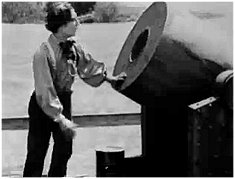 1920s Movies | ----- |
 Star Filmographies Mary Pickford Buster Keaton "Fatty" Arbuckle Rudolph Valentino Clara Bow Gloria Swanson Lon Chaney Douglas Fairbanks Sr. Charlie Chaplin | ||
===========================================================================
===========================================================================
===========================================================================
===========================================================================
Shorts & Newsreels
 newsreels Silent newsreels were first shown in theaters in 1909. The first newsreel with sound was produced by Fox Movietone News in 1927, and featured scenes of Charles Lindbergh taking off and returning from his famous transatlantic airplane flight. Fox Movietone News Pathe Weekly Hearst Metrotone News Paramount News Fox News 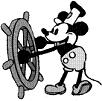 cartoons cartoonsAfter working with other animators, Walt Disney formed his own company in 1923. He introduced the character of Mortimer Mouse in a series of 1927 silent cartoon shorts. For Mortimer's first sound short in 1928, Walt's wife suggested a name change, and Mortimer became Mickey Mouse. Mortimer Mouse--Mickey Mouse Silly Symphonies Felix The Cat Steamboat Willie The Alice Comedies Laugh-O-Grams | ----- |
 shorts Stan Laurel and Oliver Hardy first worked together in 1918, when they shared a scene in the film Lucky Dog. In 1927, they also appeared together in a few Hal Roach films. They officially became a team later that year, in the silent short Putting Pants On Phillip. During 1928 and 1929, they made 24 comedy shorts together. From 1922 to 1928, Buckwheat and the gang were known as Hal Roach's Rascals. In 1928, they became Our Gang. Over the years, 176 children performed in these comedy shorts. Hal Roach's Rascals--Our Gang Laurel & Hardy Hal Roach Comedy Shorts Vitaphone Kiddies Harry Langdon Charley Chase Thelma Todd Vitaphone Shorts Dogville Comedies | ||
===========================================================================
===========================================================================
===========================================================================
===========================================================================
| Silent Films Although sound movies did exist in the 1920s, most films were silent....that is, they did not have an accompanying soundtrack. dialogue & sound effects Those early films may have lacked a soundtrack, but they were actually far from silent! Many movies were accompanied by sound effects and actors who stood on the stage and spoke the dialogue that was being mimed on the screen. 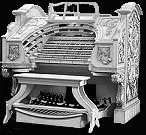 movie music Every movie theater provided some sort of musical accompaniment, whether it was a phonograph, mechanical music machine, piano, theater organ, vocalist or full orchestra. Sometimes the musicians were free to choose their own music, and sometimes the films came with sheet music and directions for when it should be played. In the early days of the cinema, music was used solely to comment on the action. Fast-paced chase music and sinister piano music are two examples of this. In the 1920s, movies were becoming more sophisticated, and background music was taking on a new importance. It was being used to create a mood or heighten an emotion, and for this, classical music was the best choice. Music lovers complained that this practice was ruining good music. Someone even suggested that they form a society for the prevention of cruelty to symphonies! | ----- |
film speed There was no standard silent film speed. The best speed at which to show a silent movie is the speed at which it was filmed. In the silent era, movie cameras were hand-cranked, and the speed of filming varied from movie to movie, sometimes even from scene to scene! Films arrived at the theater with cue sheets specifying the speed at which the projectionist should show it. Silent Films: What Was The Right Speed? Welcome To Silent Movies Glen Pringle's Silent Movie Site  do we really need sound? Most people were perfectly happy watching silent films. For them, the art form had reached its pinnacle, and there was no need to clutter it up with soundtracks. It was certainly easier to produce silent films. Without the heavy and cumbersome sound equipment, film crews could travel anywhere. With silent movies, there was no language barrier. Everyone could enjoy them. It's easy to see why "soundies" had only limited appeal at this point. | ||
===========================================================================
===========================================================================
===========================================================================
===========================================================================
| All Talking! All Singing! All Dancing! Over the years, we have been led to believe that the transition from silent films to talkies happened overnight. Nothing could be further from the truth! early sync-sound The first moving pictures were produced in 1889. From the very beginning, film pioneers experimented with ways to combine moving pictures and recorded sound. Between 1894 and 1925, they came up with a variety of gadgets that synchronized movies with cylinder and disc sound recordings. Each system had its brief period of popularity, but the results were mediocre at best. Without modern electrical recording and amplification methods, these systems weren't really practical for large theaters, and the processes were abandoned.  Vitaphone: sound on disc In 1925, the development of electronic recording made improved disc soundtracks possible. The most successful sound-on-disc process was Vitaphone, which was used between 1926 and 1936. Vitaphone discs were 16 inches wide and used a slower recording speed of 33 1/3 RPM. This allowed them to be synchronized with an 11-minute reel of film. 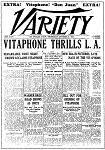 Vitaphone talkies For the first few years, Warner Brothers, First National and Hal Roach Studios used the Vitaphone process for all of their "talkies." Nearly 2,000 Vitaphone shorts were released between 1926 and 1929. In 1926, Don Juan was the first full-length film to use Vitaphone for background music and sound effects. In 1927, Warner Brothers released The Jazz Singer, which featured a small amount of dialogue on the Vitaphone soundtrack in addition to the musical accompaniment. 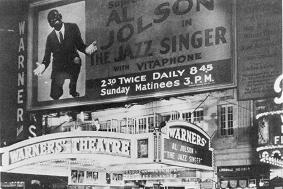
| ----- |
70 Years Of Synch-Sound "Don Juan" and "The Jazz Singer" The Vitaphone Process Motion Picture Sound 1910-1929 Video Clip: Finding His Voice~Movies That Talk Photophone Early Sound Films  "You ain't heard nothing yet!" They say timing is everything. The Jazz Singer was just what the movie-going public was ready for, and the movie was a sensation! sound on film The sound-on-film process transforms sound waves into light rays, which are filmed on the edge of the picture. Several films were made with this process during the early 1910s, but work was halted during World War I. Lee De Forest's Phonofilm process was used for a few films beginning in 1923, but it was not very successful. In 1927, a new version of the process was introduced and was named Movietone. The first public demonstration of this technology was in a 1927 Fox Movietone Newsreel. RCA's Photophone process was introduced in 1928. Although the Vitaphone process produced better sound, the sound-on-film process eliminated the possibility of the audio becoming out of sync with the action, which ultimately made it the better system. no turning back At first, the movie studios were somewhat reluctant to embrace sound movies. They had a huge investment in their silent stars, and installing sound equipment was expensive. Movie profits fell during 1927 and 1928, and the public was clamoring for more talking pictures. These two factors persuaded moviemakers to reconsider, and studios and theaters began the conversion to sound. the transition period Between 1926 and 1936, both the Vitaphone and sound-on-film processes were used by studios. By 1930, it was obvious that the sound-on-film system was the better choice, but discs lingered on because some movie theaters were still only equipped to show sound-on-disc movies.  the big microphone test In the late 1920s, most people heard their favorite movie stars "talk" for the first time. Sadly, many movie careers were ruined when an actor's voice didn't match his or her onscreen persona. Talkies destroyed the careers of Vilma Banky, Pola Negri, Clara Bow and John Gilbert, and boosted the careers of Greta Garbo and Mickey Mouse. Laurel & Hardy were the only comedians to make the transition to talkies without difficulty, because they were just as funny verbally as they were visually. | ||
===========================================================================
===========================================================================
===========================================================================
===========================================================================
 Color ColorFrom the very beginning, movie companies tried many different ways to add color to their films. Their efforts fell into two categories: 1) colorizing: using hand-tinting, color washes and toning to add color after the film is developed. 2) true color photography using the two-strip method. colorizing In the 1920s, many silent films were treated with color washes, which immersed the entire picture in a particular color to simulate a mood or time of day. Dark blue tints were used for night scenes and yellow tints were used for sunny daylight scenes. When used properly, this technique could be very effective. Toning was also used in the 1920s. This process added a second or third color to films that had already been washed in a primary color. true color photography The first experiments with true color photography were conducted around 1900. During the 1900s and 1910s, a variety of primitive two-strip methods were developed that did a fairly good job of reproducing natural color. The Technicolor Corporation was founded in 1915 and introduced their first two-strip color system in 1917. This was followed by two improved versions in 1923 and 1928. The Prizmacolor, Natural Color and Multicolor systems were also used in the 1920s. Unlike modern three-strip color systems, these two-strip systems did not reproduce the full range of colors. They had an especially difficult time registering blue tints. In the late 1920s, the development of color photography was put on hold for a few years. Technicians were focusing on adding sound, and color interfered with the clarity of the new sound-on-film recording method. During the late 1920s and early 1930s, all color films used the two-strip processes already in existence. | ----- |
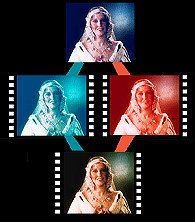 how the two-strip color system works Two negatives are combined into a single strip. One is sensitive to the blue-green spectrum, the other is sensitive to the red-orange spectrum. The image is filmed with a special camera equipped with filters to break up the hues. When the film is projected, light shines through the two strips, the spectrums are combined, and a color picture is produced. The two-strip process over-emphasized the green and orange hues, which resulted in a picture with a pink, brown or green tinge. Enough Already! After 1927, the popularity of talkies resulted in a huge increase in the number of musicals being released. Take a look at the list below....in 1928 and 1929, quite a few movies had the words singing, dancing or Broadway in the title. Before too long, the public got tired of musicals and they fell out of favor until the mid 1930s. The Development Of Color Films Technicolor | ||
===========================================================================
===========================================================================
===========================================================================
===========================================================================
1920s Movies
|
1920 One Week Way Down East The Mark Of Zorro Dr. Jeckyll & Mr. Hyde Pollyanna Suds Why Change Your Wife? Get Out And Get Under The Cabinet Of Dr. Caligari 1921 The Kid The Sheik Orphans Of The Storm Four Horsemen Of The Apocalypse The Three Musketeers The Love Light Peck's Bad Boy The Boat 1922 Nosferatu Nanook Of The North Blood And Sand Tess Of The Storm Country My Wife's Relations When Knighthood Was In Flower Foolish Wives 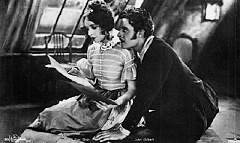
1923 Our Hospitality Safety Last! The Hunchback Of Notre Dame The Balloonatic It's A Gift The White Sister Anna Christie The Ten Commandments The Covered Wagon 
1924 Sherlock Jr. Greed The Navigator He Who Gets Slapped Peter Pan Beau Brummel Dorothy Vernon Of Haddon Hall Monsieur Beaucaire |
1925 The Gold Rush Battleship Potemkin Phantom Of The Opera Ben-Hur Go West The Wizard Of Oz Little Annie Rooney Riders Of The Purple Sage 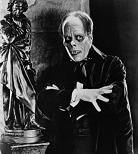
1926 The Black Pirate Don Juan Kid Boots Beau Geste The Torrent What Price Glory The Scarlet Letter Metropolis La Boheme Faust Sparrows Flesh & The Devil 1927 By Whose Hand? The Jazz Singer The General Wings Uncle Tom's Cabin After Midnight Sunrise Seventh Heaven The King Of Kings London After Midnight 1928 The Singing Fool Our Dancing Daughters My Man Steamboat Bill Jr. The Circus Street Angel Lights Of New York Beggars Of Life The Last Command 1929 The Hollywood Revue Of 1929 The Virginian The Cocoanuts Bulldog Drummond Gold Diggers Of Broadway Honky Tonk Broadway Scandals Hallelujah The Love Parade Mysterious Island Black & Tan Rio Rita Broadway Melody......(1) (2) Good News Fox Movietone Follies | ||
===========================================================================
===========================================================================
===========================================================================
===========================================================================
On Stage
|
stage tidbits *Broadway's star never shined more brightly than it did during the late 1920s. During this time, the theater industry attained heights that have never been equaled. During the 1927-28 season alone, 268 different shows played in over 70 theaters. * In the years following World War I, Broadway producers staged more dramas than usual. During the 1927-28 season, dramas outnumbered musicals, comedies and revues three to one. * Florenz Ziegfeld began his show business career in the 1890s. He became a Broadway producer in the 1900s and staged his first Follies in 1907. At various times during the 1920s, the Ziegfeld Follies starred Fanny Brice, W.C. Fields, Will Rogers and Eddie Cantor. 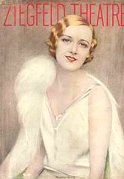 Rosalie, starring Marilyn Miller *Ziegfeld produced many other shows in addition to his popular Follies. They included Show Boat, Whoopee, Kid Boots, Rosalie, Show Girl, Sunny and Sally. *Many of the shows that Ziegfeld produced during the 1920s were created to showcase the talents of his favorite Follies performers, especially Eddie Cantor and Marilyn Miller. Another Ziegfeld production, Show Girl, starred an up-and-coming Ruby Keeler and marked the Broadway debut of Jimmy Durante. *After appearing in both the Ziegfeld Follies and George White's Scandals, W.C. Fields received his first star billing in the 1923 Broadway hit Poppy. *Emperor Jones was the first play to feature a racially integrated cast and a black actor in the leading role. *The all-black production Runnin' Wild introduced an exuberant and somewhat scandalous dance to America....the Charleston. 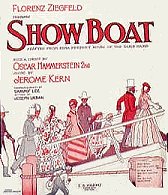 *In 1927, Show Boat launched a new era in musical theater. Unlike the frivolous, light-hearted musicals and revues of the past, this story about traveling show folk on the Mississippi River was the first real musical drama. It had a believable plot, well-defined characters and songs that contributed to the storyline. | ----- | popular stage productions drama & comedy Tess Of The D'Urbervilles Anna Christie Desire Under The Elms Strange Interlude Abie's Irish Rose Emperor Jones Appearances I'll Say She Is The Cocoanuts Animal Crackers The Fallen Star Lightnin' musicals & revues Blossom Time The Student Prince Rose Marie Show Boat Show Girl Kid Boots The Vagabond King George White's Scandals The Band Wagon Whoopee Rosalie The Song & Dance Man Sally Ziegfeld Follies Sunny Good News No No Nanette Oh, Kay! A Night In Spain Good Boy Hold Everything Poppy Andre Charlot's Revue Laff That Off Artists & Models Berlin's Music Box Revue Bombo The Jazz Singer all-black productions Shuffle Along Runnin' Wild Hot Chocolates Blackbirds Of 1928 The Plantation Revue theater links Stage Musicals Of The 20s Internet Broadway Database The Shows Of George M. Cohan | ||
return to the 1920s main page